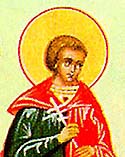List_of_students_of_the_Roman_law_school_of_Beirut
List of students at the law school of Berytus
List of students at the Roman law school of Berytus
Extant ancient texts provide a list of the names of 51 students who attended the law school of Beirut; these students came from twenty different Roman provinces. Some of those students were deemed notable and achieved fame.
Below is a list compiled by French scholar Paul Collinet; it includes the provinces and known cities from which each student originated.


| Provinces | Cities | Student names (Listed in chronological order) |
| Arabia | Severin and unnamed others Theodorus | |
| Armenia | Anonymous (Mentioned in Zacharias' "Life of Severus) | |
| Asia | Tralles | Chrysaorius |
| Bythinia | Flavianus | |
| Cappadocia | Caesarea | Menas |
| Caria | Aphrodisias | Athanasius |
| Cilicia | Tarsus | Peregrinus |
| Egypt | Alexandria | Anonymous? (in De opificio mundi) Anatolius Athanasius Isidorus |
| Heliopolis | Asclepiodotus | |
| Euphratensis | Samosata | Evagrius |
| Europe | Constantinople | Apringius Arcadius John |
| Greece | Eubea | Anonymous (In Libanius ep.1062) Hilarinus |
| Iberia | Peter | |
| Illyria | Thessaloniki | Georges |
| Lycia | Paga | Aphianus Aedesius |
| Patara | Philip Elyseus | |
| Osroene | Edessa | Anastasius |
| Palestine | Gaza | Lucius Zacharias Zenodorus Orion Zosimus Macarius |
| Maiuma | Zacharias John John Rufus | |
| Ascalon | Theodore Evagrius Stephen | |
| Pamphylia | Palladius | |
| Phoenicia | Beirut | Pamphilus Anatolius (Azutrio) Priscianus Celsinus Iulianus Constantinus Eudoxius Leontius Anatolius (professor) |
| Tyre | Gaianus | |
| Pisidia | Sozopolis | Severus |
| Syria | Antioch | Artemon Hermogenes Paeoninus Silvanus |